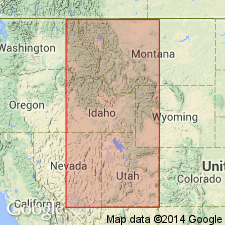
- Usage in publication:
-
- Chinese Wall Member
- Modifications:
-
- Named
- Biostratigraphic dating
- Reference
- Dominant lithology:
-
- Limestone
- Mudstone
- Chert
- AAPG geologic province:
-
- Great Basin province
- Wasatch uplift
Summary:
Named basal member (of 3) of Henderson Canyon Formation (new). "Chinese Wall" used informally in previous geological papers to describe Lower Mississippian cliffs in region; [geographic] name raised to status this paper. Type section (16.86 m thick) is lower part type Henderson Canyon Formation in S1/2 sec 12, T16S, [R35E], Oneida Co, ID; formerly member A (Wickwire and others, 1985) and member 1 [of Lodgepole Limestone] (Beus, 1968). Occurs northeastern UT and southeastern ID, Great Basin province and Wasatch uplift. If gently dipping, forms prominent cliff; if nearly vertical, forms rounded obvious topographic high. Is thin-bedded, dark to medium gray wackestones and mudstones with few grainstones, and grainstone at top. Described as very fine grained, gray, thin-bedded limestone by Beus. Graded beds and abundant tan to black chert nodules and discontinuous nodular chert bands common. 83.4 m thick at designated reference section [not described] at Leatham Hollow, Oneida Co. Disconformably overlies Beirdneau Formation at type. Fossils, abundant in some beds, dominantly crinoidal debris and solitary corals; less common fossils--brachiopods, gastropods, ostracods. Many conodonts in basal 3-8 m and sparse thereafter. Underlies Brush Canyon Member (new) of Henderson Canyon Formation. Correlation chart. Fossil list. In LOWER AND UPPER CRENULATA Zones (conodont zones). Age is middle and late Kinderhookian, Early Mississippian.
Source: GNU records (USGS DDS-6; Denver GNULEX).
For more information, please contact Nancy Stamm, Geologic Names Committee Secretary.
Asterisk (*) indicates published by U.S. Geological Survey authors.
"No current usage" (†) implies that a name has been abandoned or has fallen into disuse. Former usage and, if known, replacement name given in parentheses ( ).
Slash (/) indicates name conflicts with nomenclatural guidelines (CSN, 1933; ACSN, 1961, 1970; NACSN, 1983, 2005, 2021). May be explained within brackets ([ ]).

